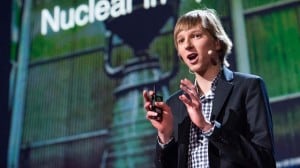
By: Amanda Froelich,
At age 14, Taylor Wilson built a nuclear fusion reactor in his parents’ garage. Now a 19 year old young adult with a plan, he recently took the stage for a TED presentation to take on an old topic: fission.
With vision to contribute to the next solution which could solve the global energy crisis, Wilson, just one of many emerging bright young minds, shared his design for a safer nuclear power plant at the recent talk.
Even though Taylor is a young nuclear physicist, he’s been a science wunderkind since he famously became the youngest person to ever create fusion at age 14. Since having graduated high school, he has further devoted himself to finding innovative solutions for some of the world’s largest problems.
In his TED talk, now 19-year-young Wilson shared his design for a small, modular fission reactor that is both less expensive and much safer to operate than today’s nuclear reactors.
The assembly-line construction, 30-year-fuel life, and low usage cost of the new model make it an ideal source of electricity for both developing nations and space explorers, according to Taylor.
During his talk, he broke down the current workings of today’s nuclear reactors in order to better describe how his model may help. Normal steam turbines work by boiling water which then turns to steam, which in effect turns the turbine and generates electricity. In his own words, Nuclear fission is really just a fancy tool for getting the water in a steam turbine to boil quickly and steadily.
Today’s nuclear power plants produce steam for their turbines using pressurized-water reactors — or big pots of water under high pressure — which are heated up with help from uranium dioxide fuel rods encased in zirconium. These rods control and maintain the nuclear fission reaction.
When nuclear power was first used to heat water in a turbine system, it was a major development in existing technology. However Wilson’s belief that this method wasn’t the most efficient stemmed his project for re-design.
Asking himself “Is fission kind of played out, or is there something left to innovate here?” led him to realize he had hit upon something that he thought had huge potential to help the world.
Instead of finding a new way to boil water, his compact, molten salt reactor found a way to heat up gas. And we mean, really heat it up.
The new fission reactor operates at 600 to 700 degrees Celsius. Because the law of thermodynamics says that high temperatures lead to high efficiencies, it is then assumed the reactor is 45 to 50 percent efficient.
Compared to traditional steam turbines which are only 30 to 35 percent efficient because their reactors run at low temperatures of about 200 to 300 degrees Celsius, Wilson’s breakthrough could mean much safer and efficient nuclear technology in the future.
And not only is his reactor hot, it’s also powerful. Despite being compact in size, the reactor generates between 50 and 100 megawatts of electricity, which is enough to power anywhere from 25,000 to 100,000 homes, according to Wilson’s calculations.
Another innovative component of Taylor’s take on nuclear fission is its source of fuel. The molten reactor runs off of “down-blended” weapon pits which are all of the highly enriched uranium and weapons-grade plutonium which have been collecting dust since the Cold War. Efficient in more than one way, the bits can instead be used for much peaceful purposes.
Safety was also a feature of design successfully included. Different from traditional nuclear power plants, the new miniature power plants would be buried below ground, making them a boon for security advocates.
And according to Wilson, his reactor only needs to be refueled every 30 years compared to the 18-month cycle of most power plants. This is positive due to the fact that sealed up underground, there is a decreased risk for proliferation.
His model is also less at risk for proliferation because it doesn’t operate at high pressure like today’s pressurized-water reactors. It also does not use ceramic control rods, which release hydrogen when heated and can lead to explosions during nuclear power plant accidents, such as Fukushima in 2011.
In the event of an accident in Wilson’s reactors, the fuel from the core would drain into a “sub-critical” setting-or-tank underneath the reactor, which neutralizes the reaction. According to Taylor, in this event the worst thing that could happen would be the destruction of the reactor.
His dedication to preserving the integrity of the Earth also remains strong. “But we’re not going to contaminate large quantities of land,” said Wilson, “So I really think that, say, 20 years it’s going to take us to get fusion and make fusion a reality, this could be the source of energy that provides carbon-free electricity.”
The new design holds grand appeal, but it’s also the young scientist’s humanitarian mindset that makes this invention a truly miraculous development. Led by ambition to make the world a better place, he has goals that this type of technology could help combat climate change, bring affordable power to the developing world, and power rockets to explore space.
“There’s something really poetic about using nuclear power to propel us to the stars,” Taylor said, “Because the stars are giant fusion reactors. They ‘re giant nuclear cauldrons in the sky…there’s something poetic about perfecting nuclear fission and using it as a future source of innovative energy.”
Sources:


